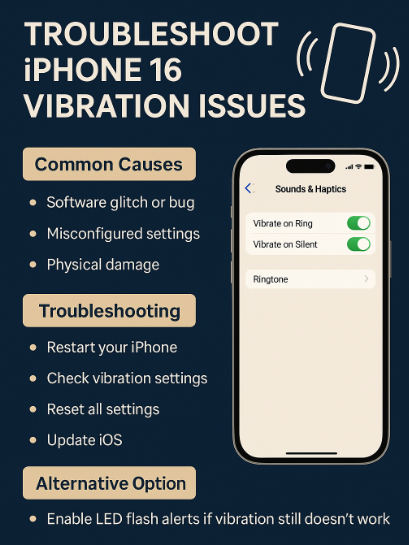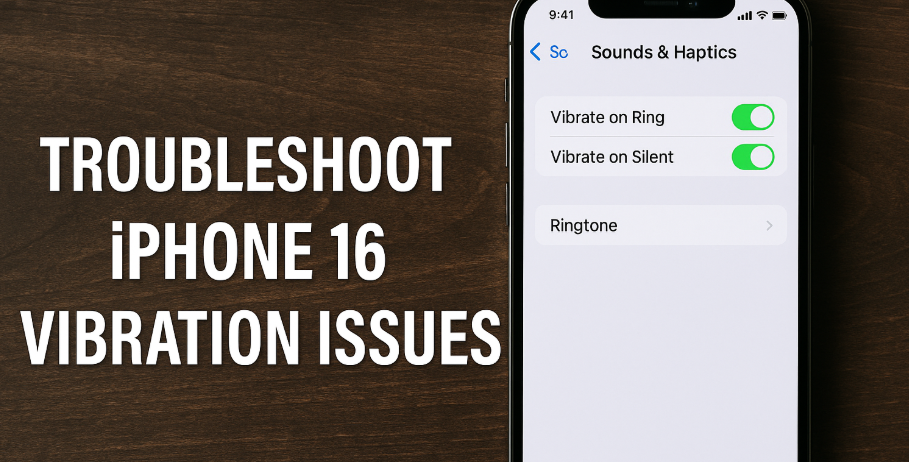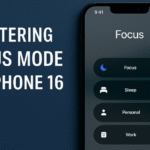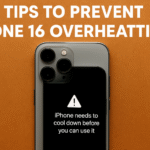The iPhone 16 is built with a premium user experience in mind, from its smooth interface to subtle feedback systems like haptics and vibrations. But what happens when those vibrations stop working? Whether you rely on it for silent alerts, incoming calls, or notification feedback, a non-functioning vibration feature can be more than an inconvenience it can be disruptive.
In this comprehensive guide, we’ll help you identify the causes, walk through effective troubleshooting steps, and suggest alternative workarounds. Let’s restore your iPhone 16’s vibration functionality.

Common Causes of iPhone 16 Vibration Not Working
Before applying any fixes, it’s crucial to understand why your iPhone 16 may not be vibrating. Here are the most common causes:
1. Software Glitches or Bugs
Temporary software bugs can interrupt vibration feedback. These are often resolved with a reboot or iOS update.
2. Misconfigured Settings
Sometimes the vibration setting for calls, messages, or notifications may be toggled off by mistake.
3. Physical Damage
If your iPhone has been dropped recently, there’s a chance the vibration motor was affected.
4. Low Battery or Battery Health Issues
When battery levels are critically low, iOS may temporarily disable haptics and vibration to conserve power.
Understanding the root cause helps you apply the right fix saving time and preventing unnecessary steps.
Step-by-Step Fixes for iPhone 16 Vibration Issues
Now that you understand the likely reasons, let’s troubleshoot and resolve the issue.
1. Restart Your iPhone
A simple restart can flush out minor glitches affecting the Taptic Engine.
Press and hold the side and volume up buttons → Slide to power off → Turn it back on after 10 seconds.
2. Check Vibration Settings
Navigate to:
Settings → Sounds & Haptics → Vibrate on Ring / Vibrate on Silent
Ensure both toggles are turned ON. You can also tap “Ringtone” → “Vibration” to test available patterns.
For personalized haptics, combine this with app switcher gesture mastery to switch tasks more effectively.
3. Reset All Settings
Still no luck? Try resetting settings (this won’t erase your data):
Settings → General → Transfer or Reset iPhone → Reset → Reset All Settings
This will restore default configurations and may fix any conflicting settings.
4. Update iOS to the Latest Version
iOS updates often include critical patches for hardware interaction bugs:
Settings → General → Software Update
Download and install any available updates.
5. Inspect for Physical Damage
If all else fails, inspect your iPhone’s vibration feedback during calls or app notifications. No response at all? The Taptic Engine may be damaged, requiring professional assistance.
Also, if you’re relying on vibration for alerts, it’s wise to enable one-handed typing mode and optimize note-taking with top iPhone 16 apps.
Optional Workaround: Use LED Flash for Alerts
If you temporarily need an alternative alert system:
-
Go to Settings → Accessibility → Audio/Visual → LED Flash for Alerts
-
Toggle ON LED Flash and Flash on Silent
This can help if you’re in meetings or loud environments and can’t rely on audible tones.
What This Means for You
A non-functioning vibration motor might seem minor, but it can affect how effectively you stay connected especially in silent environments. The good news? Most iPhone 16 vibration problems are software-related and easily fixable.
Regular updates, careful settings management, and quick testing methods can help you avoid downtime. And with tools like Safari cleanup tips or setting Chrome as your default browser, you can further personalize your device while improving responsiveness.
Conclusion:
iPhone 16 vibration issues may seem frustrating at first but they’re rarely permanent. Use this guide to apply structured troubleshooting and avoid the trap of endless trial and error.
If none of these fixes work, consider contacting Apple Support. For users under warranty or with AppleCare+, a motor replacement may be covered at no extra cost.







